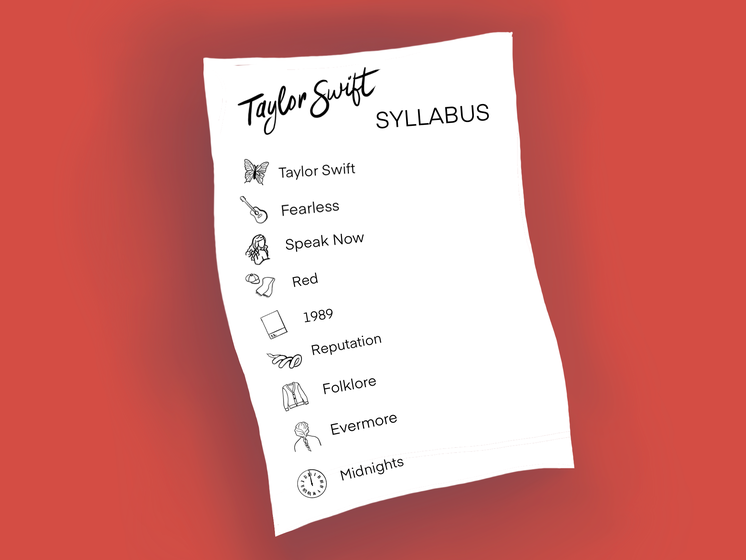{shortcode-79e0e98ce41eb7174fe425cca0e8e9da4d452aa1}
{shortcode-be29865d8a9c7908fa05930b7f2d42574eaa573c}n 2009, you couldn’t go anywhere without hearing Taylor Swift’s “You Belong with Me” on the radio, in grocery stores, and on TV. Harvard English professor Stephanie L. Burt ’94 still remembers the first time she heard it, describing it as so much “better” and “more compelling” than all the other pop songs that were playing at the time.
Fourteen years later, and Burt is still a diehard Swiftie. Her interest in Swift has followed her to the classroom. Next semester, Harvard’s English Department will debut the course “Taylor Swift and Her World,” taught by Burt. In this class, students will earn college credit for their deep dives into Swift’s lyrics, music, and influence, dissecting her catalog and reading a host of authors Burt finds relevant to understanding Swift’s artistry.
Swift is one of the biggest artists of the 21st century. She is the most streamed female musician on Spotify, has won 12 Grammy awards, and her recent Eras tour is shaping up to be the biggest tour in music history.
Still, some might be confused as to how Swift found her way onto a Harvard syllabus. But according to Burt, Swift engages with the literary canon, sometimes directly naming influences and muses in her music. For example, in her song “The Lakes” she sings the line “tell me what are my Wordsworth” in reference to the English Romantic poet William Wordsworth.
To Burt, Swift’s lyrics are an open invitation to discover these cultural touchstones. She understands Swift to be saying, “If you want to understand me better, and my time in England better, maybe you should go read some Wordsworth,” Burt says.
“And you know what, I would love to help you do that,” she adds.
Behind the course is an intentional pedagogy: Instead of teaching entirely new material, Burt hopes to give students a chance to critique art they already love.
“I try to teach only the courses that I think our students can really use — either because students want them or because our curriculum needs them,” Burt says.
The course seeks to add context and richness to the celebrity of Swift — a task especially prescient for Harvard Swifties who may have had little formal introduction to literary and aesthetic analysis.
But even with this focus on Swift, students won’t be able to write every essay on how “My Tears Ricochet” just “Hits Different.” Instead, Burt aspires to place Swift in a broader context of American art and literature.
Required readings span from Willa Cather’s portrait of the female artist in “The Song of the Lark” and James Weldon Johnson’s “The Autobiography of an Ex-Colored Man” — a novel dissecting issues of race and class in the post-Reconstruction South. Some of the works aim to address the urban-rural divide in America; the syllabus states students will learn “how to think about white texts, Southern texts, transatlantic texts, and queer subtexts.”
Burt plans to track broader shifts in American culture through the lens of Swift’s career. Swift is known for her well-documented shift from the country genre to pop music, which coincided with her move from Nashville to Manhattan. Burt intends to explore this move in the context of the South’s shifting relationship with the rest of the United States.
“Taylor Swift is someone who establishes complicated and changing relationships to the idea of Americanness and to the idea of white Americanness and of middle America,” Burt says.
Swift’s evolving relationships with class, region, and identity have sparked a range of political conversations. Despite her initial trajectory as an artist focused solely on music-making, Swift has become well-known for her political activism after facing pushback for her silence during the 2016 elections. She has championed women’s and LGBTQ+ rights, releasing anthems like “The Man” and “You Need To Calm Down” on her 2019 album “Lover.” She was also heralded as a major influence in the #MeToo movement.
Through her course, Burt asserts that this influence on politics and culture is worthy of study and analysis. After all, students will spend at least one paper delving into “the songwriting, singing, performance, or life and career of Taylor Swift.”
“We are lucky enough to be living in a time when one of our major artists is also one of the most famous people on the planet,” Burt says. “Why would you not have a course on that?”
Because of Swift’s widespread popularity, Burt expects the course will have wide engagement. “I could probably teach extraordinarily niche courses that four people would take,” Burt adds. “I don’t want to do that.”
Most of all, Burt hopes this course will speak personally to Harvard students. “Taylor Swift is a good way to think about what it’'s like to have a lot of eyes on you and to wonder what you do with your privilege,” Burt says. “To look around and ask, ‘I’m pretty ambitious and I got to this place when I was pretty young. What do I do next? What do I do with all this attention?’”
She pauses. “I think that’s very Harvard.”


